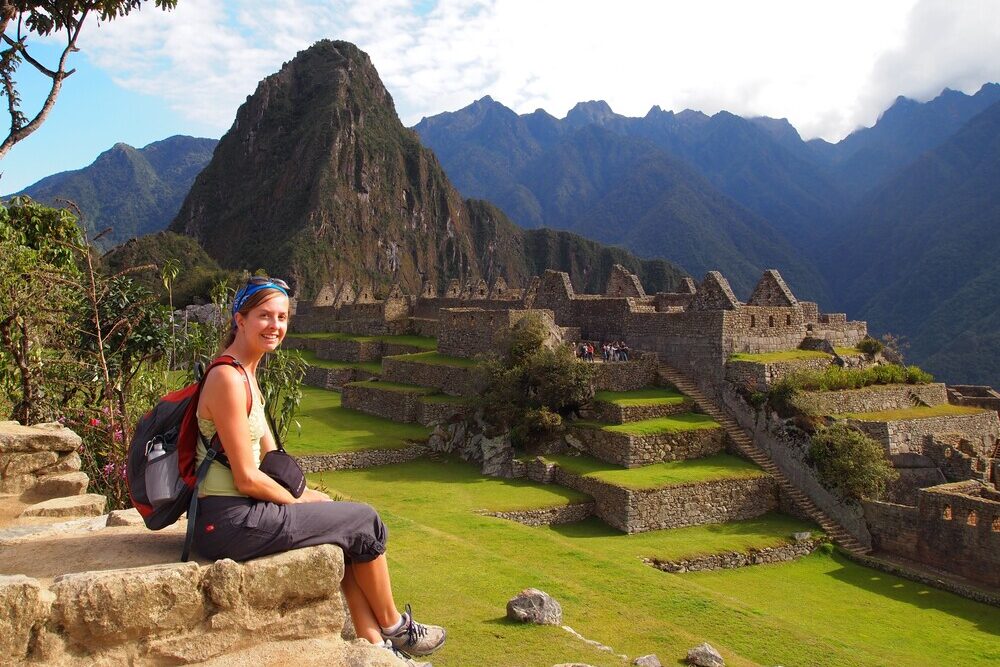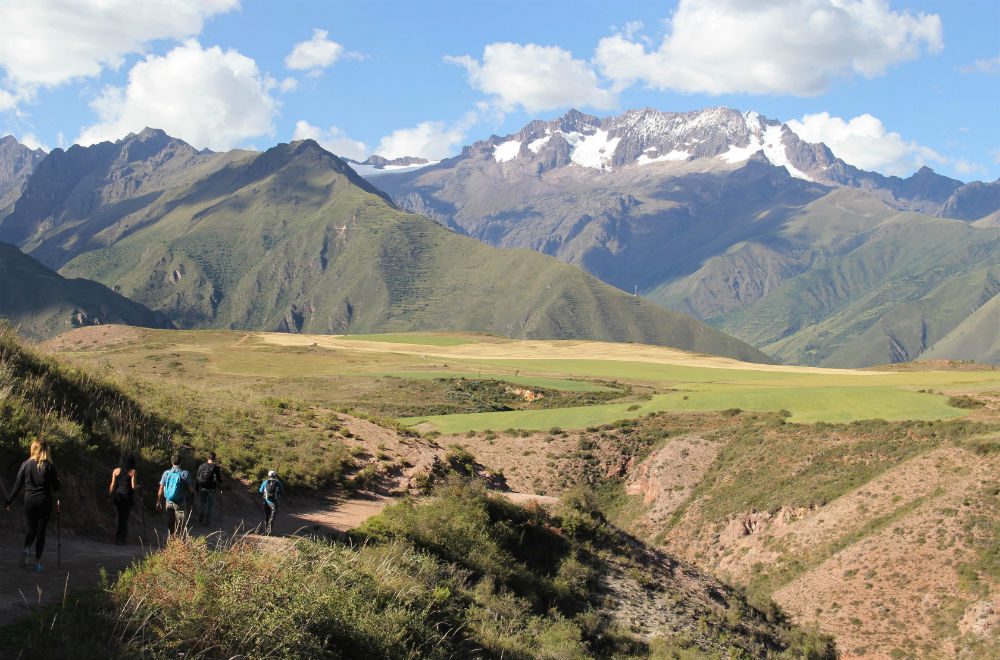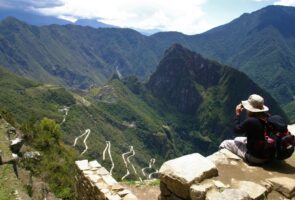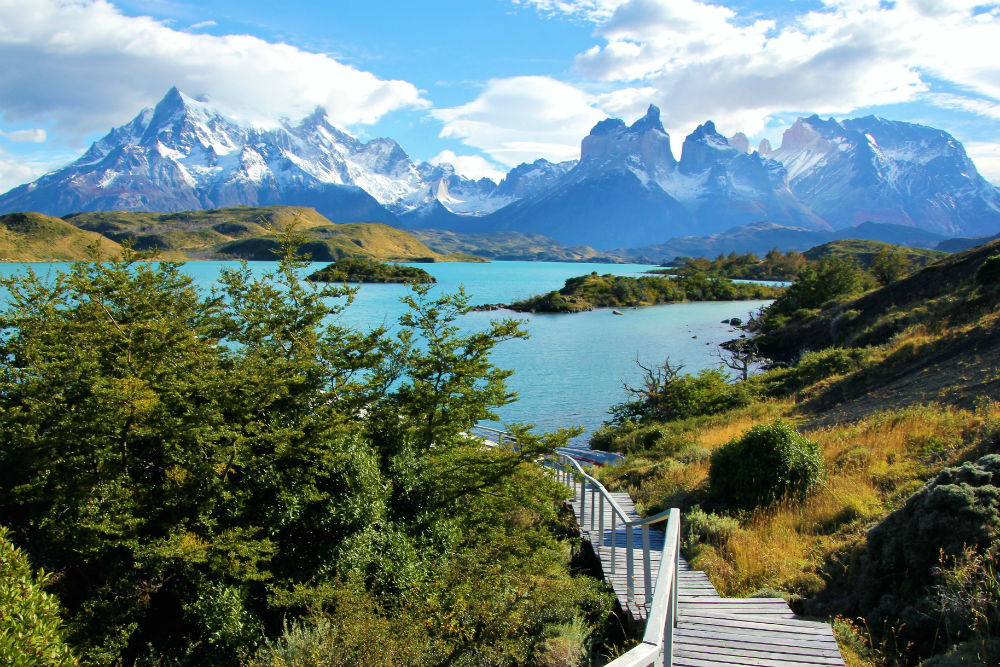Machu Picchu, Peru: Insider’s Guide
 It is magical to approach the ruins of Machu Picchu on foot via the Inca Trail. Photo: Southwind Adventures
It is magical to approach the ruins of Machu Picchu on foot via the Inca Trail. Photo: Southwind Adventures
The insider advice on this page is from one of Wendy’s Trusted Travel Experts for Peru: Tom Damon of Southwind Adventures.
An experienced trekker, Tom Damon specializes in outdoor adventures and family travel throughout South America. He’ll point you to the best hiking trails—for every skill level—at Machu Picchu and in Patagonia, and the most thrilling jungle adventures in the Amazon, whether by dugout canoe or luxe riverboat. Whether you opt for a private trip or a small-group tour, Tom will ensure you’re in the company of highly trained, highly personal English-speaking guides. As for accommodations, he knows the best-of-the-best wilderness lodges (where he often gets upgrades and other perks), as well as the finest luxury hotels. If you’re looking to cross borders or link multiple regions, Tom is a pro at making the trip seamless, dodging crowds and logistical hassles. Especially in Patagonia or Peru—where a single itinerary might include planes, cars, trains, and boats—he’ll make it all run like clockwork.

Springtime at Machu Picchu. Photo: Southwind Adventures
Where to Stay and Eat
Best bang-for-your-buck hotel
The Inkaterra Machu Picchu Pueblo Hotel delights from the moment you enter—by walking across a bridge in the cloud forest into the reception area, where you are greeted with a special iced tea brewed on the spot from leaves grown onsite. Secluded casitas are surrounded by tropical foliage and orchid gardens. The best value are the Superior Deluxe casitas, which come with a fireplace and a sitting area. Book at least two nights at this hotel for ample time to explore Machu Picchu. Following active days, enjoy the hotel gardens, which are frequented by hummingbirds, and the spa (its treatments use a lot of locally grown ingredients). Reserving an afternoon train back to the valley allows enough time on checkout day to walk the hotel’s private nature trails and learn about its spectacled bear conservation project; you might even get an up-close look at South America’s only ursine species, which is critically endangered.
Restaurants the locals love
In the Sacred Valley: The chef at Wayra—at the beloved Sol y Luna Lodge & Spa—offers evening tasting demonstrations of well-known Creole and traditional Peruvian dishes. Try the lomo saltado: fine strips of Alpaca steak stir-fried with onions, tomatoes, and yellow peppers and garnished with chickpeas and plantain. At MIL, a distinctive destination restaurant nestled at 11,706 feet near the archeological ruins of Moray, celebrated Peruvian chef Virgilio Martinez offers a farm-to-table culinary and cultural experience with an eight-course lunch of dishes reflecting the products of eight different ecosystems found in this high-altitude landscape.
In Cusco: Incanto specializes in grilled Andean dishes with an Italian influence: The pastas—made from scratch—are paired with smoked local river trout or alpaca loin aji de gallina (a spicy, creamy stew).
At Machu Picchu: The chefs at Qunuq Restaurant, in the Sumaq Hotel, are known for their modern twists on traditional Inca dishes and artful presentations. Try their delicious trout or mushroom ceviches or quinoa risotto. Nearby, Indio Feliz is a lively little café full of local color, where you can grab a drink, a savory crêpe, or a dessert.
Dishes to try
You could eat your way to Machu Picchu on the soups alone. Go for ones with quinoa (sacred to the Incas as their “mother of all grains”) or potato (more than 3,000 of the world’s 5,000 potato varieties are Andean), and don’t miss the chance to try saralawa, a soup of fresh corn, lima beans, yellow hot pepper, and huacatay (a native herb). Add some zing to any dish with aji—a spicy sauce made from tomatoes, cilantro, hot peppers, and onions.
Meals worth the splurge
For a sophisticated Peruvian- and French-inspired menu in unusual surroundings, try the MAP Café, encased in a stylish glass capsule within the courtyard of Cusco’s Museum of Pre-Columbian Art. The alpaca tenderloin stew in a demi-glace is aromatized with a red-wine reduction and accompanied by corn purée and sautéed vegetables from the organic garden.
LIMO Peruano Nikkei, in Cusco’s main square, serves traditional Japanese recipes with Peruvian influences—try the ceviches, tiraditos (similar to sashimi, marinated in local spices), and seafood rice dishes. Situated on the second story, the restaurant is also a great spot to see Cusco’s historic plaza lit up at night.
As flight schedules inevitably dictate a stopover in Lima, consider Kjolle, where owner Pia León (awarded the title of World’s Best Female Chef in 2021) pairs Lima’s seafood with Amazonian legumes in dynamic dishes such as scallops with seeds and roots from Peru’s rainforest.
What to See and Do

Hiking toward the Sacred Valley, with views of the Urubamba range. Photo: Luis Felipa
Don’t miss
The Sacred Valley of the Incas. If you arrive in Cusco and simply hop the train to Machu Picchu, you are missing out on a jewel of the Andes. Once the breadbasket of the Incas, this region of rugged mountains and colorful market towns is a highlight of the entire continent—especially for families traveling together. Be sure to allow at least two nights so you’ll have time to visit the vibrant villages of Pisac, with its well-known Sunday market and handicrafts, and Ollantaytambo, where the streets date back to Incan times. You can have an alfresco lunch and take in a Peruvian Paso horse show, or explore the valley trails by bicycle, on horseback, or on foot. Near the highland village of Chinchero, try lake kayaking at the Piuray or Huaypo lagoons to take in the beautiful views of the snowcapped Urubamba range rising above a patchwork of farms.
Don’t bother
Spending a small fortune to stay at the Sanctuary Lodge at the entrance to Machu Picchu. It’s hard to justify the minimum $1,800 nightly room rate just for the privileged location. Since the hotel is built into the side of the mountain and surrounded by vegetation, there are no rooms with prime views of the central ruins themselves. Most of the 31 rooms are small (except for the two larger suites) and not a good value for a Belmond property. There is, however, one big advantage to staying at the Sanctuary: You can be among the first at the ruins in the morning (the park opens at 6 a.m.) and the last to leave in the evening.
Best short trek
Don’t have the time to trek for days or don’t want to sleep in a tent for three nights? Then this Inca Trail shortcut is for you! Departing from the Km104 trailhead, it’s a seven-mile hike (or about six hours at elevations ranging from 7,300 to 9,000 feet). At midday, you can join up with the classic stone-paved route and ascend staircases cut by the Incas to reach the Intipunku, or Gateway of the Sun. Here, you have a bird’s-eye view of the entire Machu Picchu citadel and the surrounding forested mountains (it’s not unusual for hikers to shed tears encountering this view). Enter the citadel to catch the late afternoon light after the crowds have dispersed.
Big thrill
If Inca Trail permits are already snatched up for the time you want to go, veer off course with a herd of sure-footed llamas into the nearby Urubamba range. Without permit constraints on this rewarding, scenic route, Tom can arrange a three-day glamping expedition with two nights in the Andean backcountry, sleeping on plush air mattresses atop raised cots in spacious tents. He sends a chef, a collapsable dining table, and a mobile shower/bathroom facility, and can even arrange for a massage therapist to accompany your trek to work out any hard-earned kinks. You walk six to seven miles a day and ascend over two passes, topping out at an elevation of 14,700 feet. One of the best parts about this particular trek is that you’ll pass through traditional Quechua villages and feel like you’ve gone back in time. You’ll see how the locals farm potatoes, raise guinea pigs and llamas, and hand-weave their colorful ponchos and shawls on their backstrap looms. Villagers also graciously welcome Tom’s travelers into their modest adobe homes.
Cheap thrill
At the planetarium at the Casa Andina hotel in the Sacred Valley, you can take in the night sky from the domed observatory to seek out the Southern Cross, Centaurus, and other Southern Hemisphere celestial wonders. Using telescopes and pointers during nightly visits (weather permitting), trained staff help you spot constellations and tell you all about how the ancient Incas studied the stars.
Bragging rights
Ever wonder how massive, monumental Machu Picchu could have remained hidden from the conquistadors and the outside world for 400 years? It wasn’t until 1911 that Hiram Bingham and his Yale Expedition brought this lost city to the world’s attention, but a few years earlier, the area was explored and farmed by Agustín Lizarraga (who also happened to be one of Bingham’s guides). Tom can design a private trek with Romulo Lizarraga, Agustín’s grandson and one of the most knowledgeable and experienced guides in the Peruvian Andes. He’ll not only lead you in the footsteps of these early explorers but take you deeper into the cloud forests than other trekkers usually go and into the Mandor region, where Romulo still has relatives who work the land.
The Museo Inka, housed in Cusco’s 17th-century Palace of the Admiral, has an exquisite collection of mummies, jewelry, musical instruments, textiles, and ceramics highlighting pre-Incan life up to the period after the conquest. Tom can arrange for a private evening visit to the museum and for the museum’s chief administrator to give you an introduction and discuss her work as site archeologist. Or take a private tour of Cusco’s resplendent cathedral with Jorge Escobar Medrano, a professor, guide, and historian, and the man behind the cathedral’s recent (and extensive) restoration. The cathedral, completed in 1654, is a UNESCO World Heritage site and justly famous for its architecture, colonial artwork, and historic artifacts. If you wish, you can also combine the visit to the cathedral with an out-of-town excursion—also using Escobar as your first-rate guide—to the ruins of Pikillacta (occupied by the Wari civilization from the sixth to the ninth centuries) and to the nearby Andahuaylillas Church, known as the Sistine Chapel of the Americas for its exquisite baroque interior.
How to spend a Sunday
Sunday is the main market day in Pisac, Chinchero, and Ollantaytambo. In Chinchero, on occasion you’ll see locals using an ancient form of barter to buy their goods. In Pisac, you might catch a glimpse of the mayors from nearby villages gathering for a meeting (especially during local celebrations), decked out in their colorful wool ponchos and wide brimmed hats and carrying silver engraved staffs while sounds of conch shells mark their arrival.
Best Times to Go
April and May: Skies are mostly clear, hillsides are green following the heavier rains that end in March, and there are fewer crowds. Temperatures are also warmer on average than during the peak (June through August) season. The shoulder season of September and October is also a quieter time, and you’ll still benefit from dry-season weather.
Worst Time to Go
January through March, when there’s about a 50 percent chance of rain every day (though there’s a higher chance in January and February than in March). Mornings can still be sunny, but clouds build by afternoon, with light to moderate rain and the occasional heavy shower between 2 and 6 p.m. It’s still a fine time of year for a hotel-based, soft-adventure kind of vacation in the Andes, but if you’re planning an active hiking trip, avoid January through March.
Biggest Rookie Mistakes

Not planning soon enough for the four-day Inca Trail trek or the one-day Inca Trail hike from Km104. Permits generally sell out four to five months in advance. The Inca Trail system closes every February for maintenance and preservation efforts.
Showing up at Machu Picchu without tickets. In an effort to avoid overcrowding, Peru’s Ministry of Culture introduced an entry system that limits visitors to certain parts of the citadel, and to four hours per entry (or six hours if your ticket allows you to climb Huayna Picchu). While you might be lucky and snag a ticket when you arrive in the town below Machu Picchu, the most sought-after entry options often sell out two to three months in advance. Currently, there are four different visitors’ routes available at the citadel. Of course, Tom coordinates all the entry logistics for his travelers.
Instagram Moment
Ride the first shuttle at 5:30 a.m. to the Machu Picchu citadel. Find a high perch by the watchman’s hut just as the rising sun begins to burn off the mist to reveal the ancient ruins. You’ll have very few visitors in your shot; maybe just a lone llama grazing the terraces.
The Souvenir—and a Word of Warning
Cusco features some of the finest artisan-made crafts in South America. The Andes around Machu Picchu are known for high-quality alpaca wool products such as gloves, hats, sweaters, shawls, and vests. You’ll find plenty to choose from at the Awana Kancha textile center on the road from Cusco to Pisac, in the Sacred Valley. Also in Cusco, Kuna and Sol Alpaca have similarly high-quality wares. Elsewhere, make sure you’re buying 100 percent alpaca wool—the finest items are made from baby alpaca, which is the first wool taken from the alpacas—not a substitute made from combinations of rougher llama wool or synthetic fibers. The premium wool is found in boutiques in Cusco, Arequipa, and Lima at higher prices than the street markets, which have inferior products that sometimes blend alpaca and sheep.
Giving Back
En route to Machu Picchu, you will invariably pass through several rural communities with small schoolhouses with limited supplies. If you want to donate something, consider purchasing spiral notebooks, pencils, pens, colored pencils, an atlas, or a map in Cusco. Toothbrushes and mild toothpaste are also appreciated, or—slightly more fun—bring along a soccer ball or flying disc so you can strike up a game with the kids. Whatever items you bring, be sure to coordinate with your guide or give them to a teacher to distribute equitably.
Must-Have App
Perú Natural, by Sernanp (Peru’s Ministry of Environment), has authoritative tips and photos of the country’s most scenic natural areas, complete with directions, weather, and recommended tour operators.
Airport Intel
Ask the agent at the airline counter for a window seat on the left side of the plane when flying from Lima to Cusco, for a glimpse of the glaciated high Andean peaks of the Vilcabamba range, which soar over 19,000 feet.
Tipping Tips
Bring small denominations of U.S. dollars and soles (the local currency, which can be obtained at the local airports or at your hotel) for tips and purchases; getting change is not easy. The service charge you see at the bottom of a restaurant bill is not a tip but part of the wages divided among all restaurant staff. Best to give your tip—about 10 percent—directly to your waiter.
Don’t Forget to Pack

Wi-Fi can be spotty at hotels in the Andes around Machu Picchu. If you need a strong signal, bring along a small wireless extender to boost the hotel’s signal.









